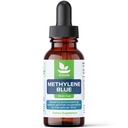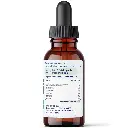- All Products
- Methylene Blue Drops
Methylene Blue Drops
https://life-enthusiast.com/shop/methylene-blue-3290 https://life-enthusiast.com/web/image/product.template/3290/image_1920?unique=f8918ffPowerful Antioxidant
- Helps Calm Nerves and Reduce Stress
- Enhances Energy and Performance
- May Boost Brain Functions
Terms and Conditions
30-day money-back guarantee
Shipping: 2-3 Business Days
Methylene Blue is a powerful antioxidant, critical for health.
Antioxidants help neutralize the effects of stress and aging. They're necessary for a healthy brain, nerves and muscles (including heart).
A deficit may cause rapid aging, emotional instability, loss of mental power.
The antioxidant properties of Methylene Blue support:
- Helps calm nerves and stress
- May improve sleep and energy
- May improve immunity
- May boost brain functions, mental alertness and good moods
- Helps regulate homocysteine levels
- Plays a role in neurological activity
- Enhances growth and repair of all cells
- Aids in metabolism of carbohydrates and fats
- May improve protein synthesis
- Helps protect against nerve damage
- Especially great for vegetarians who are often deficient..
Keep on-hand for any time you need a mood and/or energy lift.
Methylene Blue is a strong dye that has been used in the past to treat malaria, urinary tract infections, and a rare blood condition called methemoglobinemia.
Due to the vast range of applications, Methylene Blue has earned the title of "Universal Supplement".
Symptoms Associated with Antioxidant Deficiency
Abnormal gait, allergies, bone loss, chronic fatigue, constipation, very low moods, digestive disorders, dizziness, drowsiness, enlargement of the liver, eye disorders, hallucinations, headaches (including migraines), inflammation of the tongue, irritability, labored breathing, memory loss, moodiness, nervousness, neurological damage, palpitations, low blood hemoglobin, ringing in the ears, and spinal cord degeneration.
Antioxidant Properties
Methylene blue acts as an antioxidant, helping to neutralize harmful free radicals in the body that can cause cellular damage and contribute to various diseases. Studies suggest this may include inhibiting viral infections.
Improves Mitochondrial Function
Methylene blue may enhance mitochondrial function, potentially leading to increased energy production within cells.
Neuroprotective Effects
Methylene blue has shown promise in protecting against neurodegenerative symptoms associated with Alzheimer's and Parkinson's by reducing oxidative stress and preserving neuronal function.
Enhances Cognitive Function
Some studies suggest that methylene blue supplementation may improve cognitive function, including memory and attention, possibly by increasing cerebral blood flow and supporting neuronal health.
Potential Anti-aging Effects
Due to its antioxidant properties and effects on mitochondrial function, methylene blue may have anti-aging effects, helping to reduce age-related decline in cellular function and overall health.
Antimicrobial Activity
Methylene blue exhibits antimicrobial properties and has been used in the treatment of certain infections.
Treatment for Methemoglobinemia
Methylene blue is a common treatment for methemoglobinemia, a condition in which the blood contains an abnormal amount of methemoglobin, reducing its ability to carry oxygen. Methylene blue helps convert methemoglobin back to normal hemoglobin, restoring oxygen-carrying capacity.
Potential for Tumor Inhibition
Some research suggests that Methylene Blue may have the ability to inhibit tumor growth and induce apoptosis.
Mood Enhancement
There is evidence to suggest that Methylene Blue may have mood-enhancing effects, possibly by increasing serotonin levels in the brain.
1 drop contains 0.5 mg of Methylene Blue
Serving Size: 5 to 10 drops
Servings/Container:
- 30ml bottle: 60-120 servings
- 120ml bottle: 240-480 servings
Contains:
| INGREDIENTS | DRI |
| Specially Activated Ancient Glacier Water | 95% |
| MSM (MethylSulfonylMethane) | 4% |
| Methylene Blue | 1% |
| Vegetable Glycerin | 0.1% |
| Colloidal Copper | 0.01% |
| Trace Minerals | 0.1% |
| Colloidal Zinc | 0.1% |
| Colloidal Silver | 0.001% |
| Colloidal Gold | 0.01% |
| Hyaluronic Acid | 0.01% |
| *DRI (Dietary Reference Intake) Not Significant or Established |
Directions for Use
Shake before use.
Take 5 to 10 drops either directly in the mouth, or in 4 ounces of water and drink.
Therapeutic dose used in medical settings is 1 mg per pound of body weight. That would be 300 drops (3 teaspoons) for 150 lbs.
Caution:
If you are using pharmaceutical drugs, taking a large dose of Methylene Blue may affect the drug effects. Here is a link to an article that is written as precautions for intravenous Methylene Blue use.
Store in a cool, dry place. Keep out of reach of children.
This liquid will stain everything it touches.
You will see blue or green urine color.
Recommended Use
Helps enhance energy, calm nerves and stress. May boost brain functions.
Contraindications
Methylene Blue is a potent MAO inhibitor with potential potent drug interactions (SSRI and MAOI) that may lead to serious complications.
Be cautious when considering its use. It may cause Serotonin Syndrome, a potentially life-threatening condition that may necessitate hospitalization.

Cagno, V., Medaglia, C., Cerny, A. et al. Methylene Blue has a potent antiviral activity against SARS-CoV-2 and H1N1 influenza virus in the absence of UV-activation in vitro. Sci Rep 11, 14295 (2021). https://doi.org/10.1038/s41598-021-92481-9
Dabholkar N, Gorantla S, Dubey SK, Alexander A, Taliyan R, Singhvi G. Repurposing methylene blue in the management of COVID-19: Mechanistic aspects and clinical investigations. Biomed Pharmac other. 2021 Oct;142:112023. doi: 10.1016/j.biopha.2021.112023. Epub 2021 Aug 10. PMID: 34399199; PMCID: PMC8352658.
Delport, A., Harvey, B.H., Petzer, A. et al. Methylene blue and its analogues as antidepressant compounds. Metab Brain Dis 32, 1357–1382 (2017). https://doi.org/10.1007/s11011-017-0081-6
Naylor, G. J., Martin, B., Hopwood, S. E., & Watson, Y. (1986). A two-year double-blind crossover trial of the prophylactic effect of methylene blue in manic-depressive psychosis. The British Journal of Psychiatry, 149(3), 353-356. https://pubmed.ncbi.nlm.nih.gov/3091097/
Medina, D. X., Caccamo, A., & Oddo, S. (2011). Methylene blue reduces aβ levels and rescues early cognitive deficit by increasing proteasome activity. Brain Pathology, 21(2), 140-149. https://pubmed.ncbi.nlm.nih.gov/20731659/
Atamna, H., & Kumar, R. (2010). Protective role of methylene blue in Alzheimer's disease via mitochondria and cytochrome c oxidase. Journal of Alzheimer's Disease, 20(2), 439-452. PMID: 20463399. https://pubmed.ncbi.nlm.nih.gov/20463399/
Jang, D. H., Nelson, L. S., & Hoffman, R. S. (2013). Methylene blue for distributive shock: a potential new use of an old antidote. Journal of Medical Toxicology, 9(3), 242-249. https://www.ncbi.nlm.nih.gov/pmc/articles/PMC3770994/
Tucker, D., Lu, Y., & Zhang, Q. (2018). From mitochondrial function to neuroprotection – an emerging role for methylene blue. Molecular Neurobiology, 55(6), 5137-5153. https://www.ncbi.nlm.nih.gov/pmc/articles/PMC5826781/
Schirmer, R. H., Coulibaly, B., Stich, A., Scheiwein, M., Merkle, H., Eubel, J., ... & Kouyaté, B. (2003). Methylene blue as an antimalarial agent. Redox Report, 8(5), 272-275. https://pubmed.ncbi.nlm.nih.gov/14962363/
Mak, R. S. P., & Liebelt, E. L. (2021). Methylene Blue: An Antidote for Methemoglobinemia and Beyond. Pediatric Emergency Care, 37(9), 474-477. https://pubmed.ncbi.nlm.nih.gov/34463662/
Haouzi, P., Gueguinou, M., Sonobe, T., Judenherc-Haouzi, A., Tubbs, N., Trebak, M., Cheung, J., & Bouillaud, F. (2018). Revisiting the physiological effects of methylene blue as a treatment of cyanide intoxication. Clinical Toxicology, 56(9), 828-840. https://www.ncbi.nlm.nih.gov/pmc/articles/PMC6086742
Scigliano, G., & Scigliano, G. A. (2020). Acute respiratory distress syndrome from Covid-19: A perfect storm from free radicals? Proposal for a new treatment. Medical Hypotheses, 144, 110120. https://www.ncbi.nlm.nih.gov/pmc/articles/PMC7373063/
Genrikhs, E. E., Stelmashook, E. V., Voronkov, D. N., Novikova, S. V., Alexandrova, O. P., Mironova, R. I., ... & Skrebitsky, V. G. (2020). The delayed neuroprotective effect of methylene blue in experimental rat brain trauma. Antioxidants, 9(5), 377. https://www.ncbi.nlm.nih.gov/pmc/articles/PMC7278725/
Hrushesky, W. J., Berestka, J. S., von Roemeling, R., Olshefski, R., Langevin, T. R., Potish, R. A., Delaney, J. P., Ellefson, M., & Schwartz, S. (1988). Methylene blue protects intestinal mucosa from free radical-mediated sublethal radiation damage. Free Radical Biology and Medicine, 5(4), 207-213. https://pubmed.ncbi.nlm.nih.gov/3151072/
Haluzik, M., Nedvídková, J., & Skrha, J. (1999). Treatment with the NO-synthase inhibitor, methylene blue, moderates the decrease in serum leptin concentration in streptozotocin-induced diabetes. Endocrine Research, 25(2), 163-171. https://pubmed.ncbi.nlm.nih.gov/10382678/
Ogasawara, K. (2018). Helicobacter pylori Eradication Using a Light-Emitting Diode and Methylene Blue. Laser Therapy, 27(1), 21-25. https://www.ncbi.nlm.nih.gov/pmc/articles/PMC5958231/
Salah, M., Samy, N., & Fadel, M. (2009). Methylene blue mediated photodynamic therapy for resistant plaque psoriasis. Journal of Drugs in Dermatology, 8(1), 42-49. https://pubmed.ncbi.nlm.nih.gov/19180895/
Li, Z., Lang, Y., Sakamuru, S., Samrat, S., Trudeau, N., Kuo, L., ... & Xia, M. (2020). Methylene blue is a potent and broad-spectrum inhibitor against Zika virus in vitro and in vivo. Emerging Microbes & Infections, 9(1), 2404-2416. https://www.ncbi.nlm.nih.gov/pmc/articles/PMC7646565/
Manghelli, J., Brown, L., Tadros, H. B., & Munfakh, N. A. (2015). A Reminder of Methylene Blue's Effectiveness in Treating Vasoplegic Syndrome after On-Pump Cardiac Surgery. Texas Heart Institute Journal, 42(5), 491-494. https://www.ncbi.nlm.nih.gov/pmc/articles/PMC4591896/
Edwards, K. (2016). New Twist on an Old Favorite: Gentian Violet and Methylene Blue Antibacterial Foams. Advances in Wound Care, 5(1), 11-18. https://www.ncbi.nlm.nih.gov/pmc/articles/PMC4717508/
Shin, S. Y., Kim, T. H., Wu, H., Choi, Y. H., & Kim, S. G. (2014). SIRT1 activation by methylene blue, a repurposed drug, leads to AMPK-mediated inhibition of steatosis and steatohepatitis. European Journal of Pharmacology, 727, 115-124. https://pubmed.ncbi.nlm.nih.gov/24486702/
Vonlanthen, R., Beer, J. H., & Lauterburg, B. H. (2000). Effect of methylene blue on the disposition of ethanol. Alcohol and Alcoholism, 35(5), 424-426. https://academic.oup.com/alcalc/article/35/5/424/206576
Dinc, S., Caydere, M., Akgul, G., Yenidogan, E., Hücümenoglu, S., & Rajesh, M. (2015). Methylene Blue inhibits the inflammatory process of the acetic acid-induced colitis in the rat colonic mucosa. International Surgery, 100(7-8), 1166-1173. https://pubmed.ncbi.nlm.nih.gov/26062761/
Broulik, P. D., & Schreiber, V. (1994). Methylene blue inhibits the stimulation of bone mass by high doses of estradiol in male rats. Endocrine Regulations, 28(3), 141-144. PMID: 7589472. https://pubmed.ncbi.nlm.nih.gov/7858245/
Park, J. S., Jou, I., & Park, S. M. (2014). Attenuation of noise-induced hearing loss using methylene blue. Cell Death & Disease, 5(4), e1200. https://www.researchgate.net/publication/261881758_Attenuation_of_noise-induced_hearing_loss_using_methylene_blue
Jordan B, Margulies A, Cardoso F, on behalf of the ESMO Guidelines Committee, the EONS Education Working Group, the EANO Guideline Committee. Systemic anticancer therapy-induced peripheral and central neurotoxicity: ESMO–EONS–EANO Clinical Practice Guidelines for diagnosis, prevention, treatment and follow-up. Ann Oncol. 2020 Oct 1;31(10):1306-1319. https://www.annalsofoncology.org/article/S0923-7534(20)39938-5/fulltext
Payne, A. J., Kaja, S., Sabates, N. R., & Koulen, P. (2013). A case for neuroprotection in ophthalmology: developments in translational research. Mo Med, 110(5), 429-36. https://pubmed.ncbi.nlm.nih.gov/24279196/
Xiong, Z. M., Choi, J. Y., Wang, K., Zhang, H., Tariq, Z., Wu, D., ... & Cao, K. (2016). Methylene blue alleviates nuclear and mitochondrial abnormalities in progeria. Aging Cell, 15(2), 279-290. https://pubmed.ncbi.nlm.nih.gov/26663466/
Elizabeth S Smith, Madeline E Clark, Gwendolyn A Hardy, David J Kraan, Elisa Biondo, F Gonzalez-Lima, Lawrence K Cormack, Marie Monfils, Hongjoo J Lee. Daily consumption of methylene blue reduces attentional deficits and dopamine reduction in a 6-OHDA model of Parkinson's disease. Neuroscience, Volume 359, 2017, Pages 8-16. https://pubmed.ncbi.nlm.nih.gov/28694175/
Cui ZQ, Li WL, Luo Y, Yang JP, Qu ZZ, Zhao WQ. Methylene Blue Exerts Anticonvulsant and Neuroprotective Effects on Self-Sustaining Status Epilepticus (SSSE) Induced by Prolonged Basolateral Amygdala Stimulation in Wistar Rats. Med Sci Monit. 2018;24:161-169. https://www.ncbi.nlm.nih.gov/pmc/articles/PMC5771162/
Jiang, Z., & Duong, T. Q. (2016). Methylene blue treatment in experimental ischemic stroke: A mini-review. Brain Circulation, 2(1), 48–53. https://www.ncbi.nlm.nih.gov/pmc/articles/PMC4817094/
Li X, Tang C, Wang J, Guo P, Wang C, Wang Y, Zhang Z, Wu H. Methylene blue relieves the development of osteoarthritis by upregulating lncRNA MEG3. Exp Ther Med. 2018 Apr;15(4):3856-3864. https://www.ncbi.nlm.nih.gov/pmc/articles/PMC5863598/
Ramsay, R. R., Dunford, C., & Gillman, P. K. (2007). Methylene blue and serotonin toxicity: inhibition of monoamine oxidase A (MAO A) confirms a theoretical prediction. British Journal of Pharmacology, 152(6), 946–951. https://www.ncbi.nlm.nih.gov/pmc/articles/PMC2078225/
Ramsay RR, Dunford C, Gillman PK. Methylene blue and serotonin toxicity: inhibition of monoamine oxidase A (MAO A) confirms a theoretical prediction. Br J Pharmacol. 2007 Nov;152(6):946-51. https://pubmed.ncbi.nlm.nih.gov/17721552/
Clinical Trials using Methylene Blue in which you could participate https://www.cancer.gov/research/participate/clinical-trials/intervention/methylene-blue





